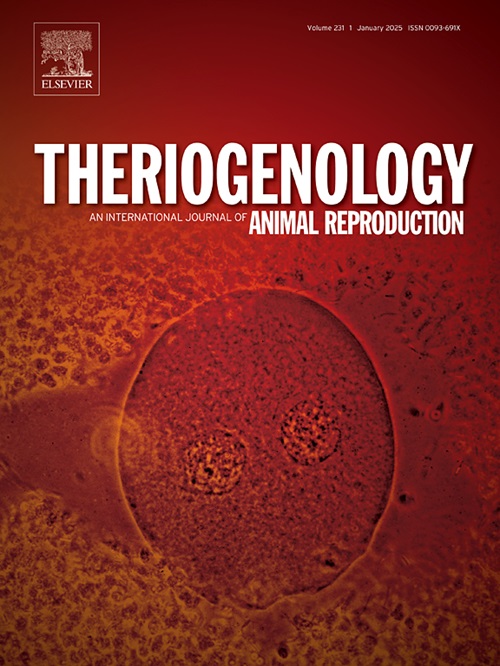猪妊娠期黄体中瘦素及其长形受体的表达及瘦素对体外黄体功能的保护作用
IF 2.4
2区 农林科学
Q3 REPRODUCTIVE BIOLOGY
引用次数: 0
摘要
虽然瘦素及其长形受体(LEPR)在猪卵巢中已被发现,但它们在妊娠母猪黄体(CL)功能调节中的直接作用尚未明确。在本研究中,我们研究了瘦素和LEPR在妊娠期猪肝细胞中的表达,并在体外评估了该激素对肝细胞功能的影响。Leptin和LEPR在妊娠期CL中持续表达,且表达模式大体相似,妊娠早期和中期较高,晚期较低。免疫组化分析显示,leptin和LEPR主要定位于黄体细胞,在CL的早期和中期表现为强免疫染色,晚期表现为弱免疫染色。瘦素1-100 nM浓度显著提高培养黄体细胞的活力(P <;0.05),并促进黄体酮的释放(P4),呈剂量依赖性。此外,瘦素可以减轻前列腺素F2α (PGF2α)诱导的细胞活力和P4释放的降低。此外,瘦素对促黄体生成素(LH)和前列腺素E2 (PGE2)的释放有刺激作用,但对PGF2α的分泌有抑制作用。综上所述,瘦素和LEPR在妊娠母猪CL中的存在,以及该激素对黄体细胞活力和P4、LH、PGE2释放的刺激作用,提示瘦素对妊娠母猪CL功能具有正向调节作用。本文章由计算机程序翻译,如有差异,请以英文原文为准。
Expression of leptin and its long-form receptor in the porcine corpus luteum during pregnancy and the protective role of leptin in corpus luteum function in vitro
Although the hormone leptin and its long-form receptor (LEPR) have been identified in the porcine ovary, their direct roles in mediating corpus luteum (CL) function in pregnant sows have not been clearly defined. In this study, we investigated leptin and LEPR expression in the porcine CL during pregnancy and evaluated the effect of the hormone on CL function in vitro. Leptin and LEPR were continuously expressed in the CL throughout pregnancy, and their expression patterns were generally similar, with higher levels in the early and middle stages of pregnancy and lower levels in the late stage. Immunohistochemical analysis revealed that both leptin and LEPR were predominantly localized in the luteal cells, with strong immunostaining observed in the early and middle stages CL and weak immunostaining in the late stage. Leptin 1–100 nM concentrations significantly increased the viability of cultured luteal cells (P < 0.05) and promoted their release of progesterone (P4) in a dose-dependent manner. Furthermore, leptin attenuated the prostaglandin F2α (PGF2α)-induced decreases in cell viability and P4 release. Additionally, leptin was found to have stimulatory effects on luteinizing hormone (LH) and prostaglandin E2 (PGE2) release but an inhibitory effect on PGF2α secretion. In conclusion, the presence of leptin and LEPR in the CL and the stimulatory effects of the hormone on the viability of luteal cells and their release of P4, LH, and PGE2 suggest that leptin has a positive regulatory effect on CL function in pregnant sows.
求助全文
通过发布文献求助,成功后即可免费获取论文全文。
去求助
来源期刊

Theriogenology
农林科学-生殖生物学
CiteScore
5.50
自引率
14.30%
发文量
387
审稿时长
72 days
期刊介绍:
Theriogenology provides an international forum for researchers, clinicians, and industry professionals in animal reproductive biology. This acclaimed journal publishes articles on a wide range of topics in reproductive and developmental biology, of domestic mammal, avian, and aquatic species as well as wild species which are the object of veterinary care in research or conservation programs.
 求助内容:
求助内容: 应助结果提醒方式:
应助结果提醒方式:


